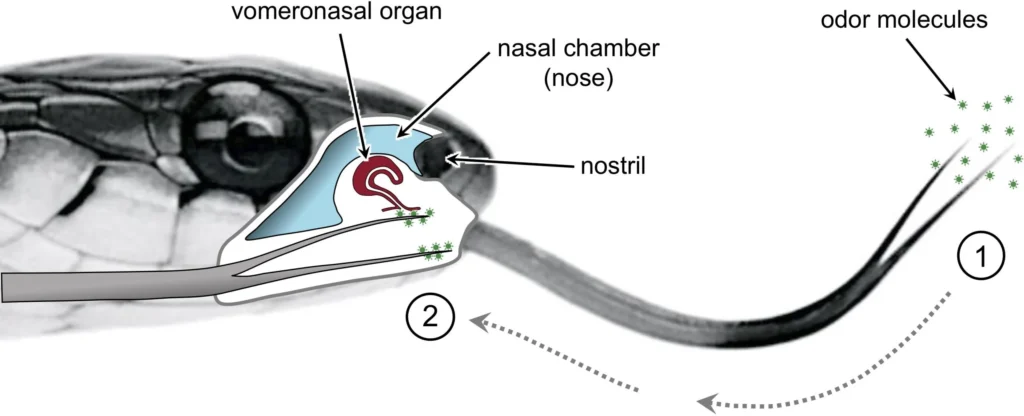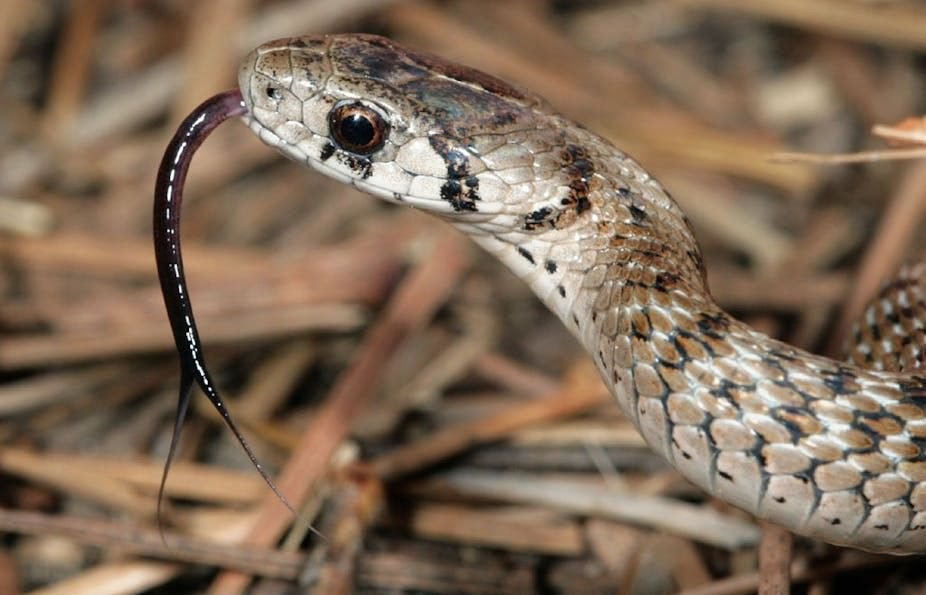


Can fish regrow fins after they lose them?
February 26, 2024


Are Snakes Faster Than Humans? [Fastest Snakes Compared]
February 26, 2024Snakes are fascinating creatures that experience the world around them uniquely. Unlike us, snakes can “taste” the air! This might sound strange, but it’s true. Snakes stick out their tongues to pick up tiny bits from the air. These clues tell the snake about what’s happening around them. They can sense if food is nearby or a predator is lurking.
This special way of tasting the air helps snakes to survive and understand their environment. In this blog, we will explore how snakes use their tongues to taste the air and why it’s essential for them to do so.
Can snakes taste the air?
No, snakes cannot “taste” the air quite literally. However, they use their forked tongues to collect tiny particles from the air, which are then analyzed by a special organ in their mouths called the Jacobson’s Organ (Also known as the Vomeronasal organ). This process helps them detect prey, predators, and other environmental cues, allowing them to “taste” their surroundings.
Understanding the snake’s tongue
Let’s understand the snake’s tongue first:


Snake Tongue Anatomy
What Does a Snake’s Tongue Look Like?
A snake’s tongue is long, forked, and very flexible. It’s not like human tongues because it’s split into two parts at the end. This forked design is helpful for their unique way of sensing the world.
What Does a Snake’s Tongue Do?
The main job of a snake’s tongue is to collect tiny bits from the air. These bits can be from anything around them, like plants, animals, or even the ground. When a snake flicks its tongue out, it’s grabbing these tiny bits to learn about its surroundings.
Why Do Snakes Flick Their Tongues Into the Air?
Snakes flick their tongues to “taste” the air. By doing this, they can figure out where their next meal might be or if there’s danger nearby. Each tongue flick is like a quick check to see what’s happening around them. This helps them decide where to go and what to do next.
Recommended Reading: Can snakes be pets? (Do they like being a pet?) Pros/Cons
What is the Jacobson’s organ in the snake’s mouth?
The Jacobson’s Organ, also known as the vomeronasal organ, is a super cool feature inside a snake’s mouth. It’s like a special sensor that helps snakes “taste” the air. Humans do not have this organ, making it a unique snake tool.
How Does the Jacobson’s Organ Work?
When a snake flicks its tongue out, it’s not just doing it for fun. The tongue picks up tiny particles from the air, like smells from nearby animals or plants. After the tongue returns to the mouth, the snake touches it to the Jacobson’s Organ. This organ then takes over, analyzing all the bits collected by the tongue.
Once Jacobson’s Organ gets the information from the tongue, it tells the snake’s brain what’s around it. This could be the scent of a mouse, the trail of another snake, or even the warning sign of a predator nearby. By processing these smells, the snake can make smart choices about where to go, what to eat, and how to stay safe.


How Does the Jacobson’s Organ Work?
How does ‘tasting’ the air help snakes avoid predators?
Just as snakes can detect their prey, they can sense danger through the air. If a predator is close, its scent will be in the air. When a snake tastes this scent, it gets a warning signal. This helps the snake decide to hide or escape, keeping it safe from harm.
How do snakes navigate their environment?
Humans rely mainly on their eyes and ears to understand the world, but our sense of smell and taste is less developed than a snake’s ability to taste the air. Imagine if we could taste the air to know what’s for dinner or if someone’s baking cookies in the next room—snakes do something similar, but with their surroundings.
Snakes don’t have GPS, but they have something just as cool—their tongue. By tasting the air, snakes learn a lot about where they are. They can sense if they’re near water, a warm sunny spot, or entering a new territory. This “tasting” helps them find their way around, look for safe places to rest, or decide if it’s time to move to a new area.


Snake Navigating Environment
How do other animals’ sensory mechanisms compare?
Different animals have unique ways of sensing the world. For example, dogs have an incredible sense of smell, much better than humans, and they use it to understand their environment, track people or objects, and communicate.
Bats use echolocation, sending sound waves and listening for the echoes to navigate and hunt in the dark. Compared to these, snakes’ air tasting is their unique method, allowing them to detect chemical cues in the environment.
Each animal’s sensory mechanism is adapted to its needs, with snakes being one of the most unique in the animal kingdom, offering them a silent but informative way to interact with their world.
Fascinating facts about snake sensory capabilities
1: Snakes Can “See” Heat
Some snake species, like pit vipers, have an incredible ability to detect heat. They have special organs called pit organs located between their eyes and nostrils, allowing them to “see” the warmth of their prey in complete darkness. This thermal vision works alongside their air tasting, making them formidable hunters day or night.
2: Sea Snakes Taste the Water
As land snakes taste the air, sea snakes have adapted their tasting abilities to the water. They flick their tongues in the water to detect prey, predators, and mates. This adaptation shows the versatility of their sensory capabilities, allowing them to thrive in completely different environments.
3: The Range of Snake’s “Taste”
The distance a snake can “taste” varies among species. Some snakes, especially those that hunt in wide-open spaces, can detect prey or threats from several meters away. This long-range detection system is crucial for survival, allowing them to hunt or hide effectively.
4: Snakes Use Taste to Communicate
Some snakes use chemical cues in the air for hunting, avoiding danger, and communication. During mating seasons, female snakes release pheromones that male snakes can detect through air tasting. This helps them find a mate across distances where visual cues would be impossible.
5: The Sensitivity of the Snake’s Tongue
A snake’s tongue is incredibly sensitive to different chemicals in the air. This sensitivity is so refined that snakes can detect changes in their environment, such as the presence of water sources, shelter areas, and even the trail left by a prey animal or a rival snake days after it has passed.
6: Unique Adaptations Across Species
Different snake species have developed unique tasting abilities adapted to their specific habitats and lifestyles. For example, arboreal (tree-living) snakes can detect the scent of birds and their nests, while desert-dwelling snakes are adept at sensing the faint trails left by rodents on the sand.
Conclusion
In conclusion, the ability of snakes to “taste” the air is a fascinating and vital survival mechanism. This unique sensory skill allows them to detect prey, avoid predators, navigate their environment, and even communicate with one another. It’s a perfect example of how animals have adapted incredible abilities to thrive in their specific habitats.
![Can Snakes Taste Air? [Detailed Guide]](https://petsfm.com/wp-content/uploads/2024/02/Can-Snakes-Taste-Air-960x540.png)


